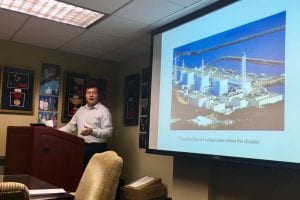 The Tower Center Sun & Star Japan East Asia Program held a discussion Sept. 7 with SMU Anthropology Assistant Professor Nicolas Sternsdorff Cisterna examining how citizens banded together to demand safe food after the 2011 nuclear meltdown in Fukushima, Japan.
The Tower Center Sun & Star Japan East Asia Program held a discussion Sept. 7 with SMU Anthropology Assistant Professor Nicolas Sternsdorff Cisterna examining how citizens banded together to demand safe food after the 2011 nuclear meltdown in Fukushima, Japan.
The three disasters
The Pacific coast of Tōhoku, Japan was hit by an earthquake with a magnitude of 9.0 and a subsequent tsunami of 30-foot waves March 11, 2011. More than 16,000 people died as a result of the disasters and more than 100,000 were displaced. The tsunami also triggered a nuclear meltdown at the Fukushima Dai-ichi nuclear plant, which released radioactive elements into the air.
Sternsdorff-Cisterna’s talk, a presentation on his forthcoming book, looked at how mistrust of the Japanese state led people to band together to demand stricter safety standards on food from the Fukushima prefecture, or government district. After the nuclear meltdown there was disagreement among different states about what level of radioactive poisoning in food was safe to consume. European countries were much more conservative after Chernobyl than Japan and the U.S. were after Fukushima. The goal was to cause as little harm to area farmers as possible, while still insuring the safety of the consumers.
The neoliberal subject
This discrepancy in safety standards between the European reaction and the Japanese and U.S. reaction worried Japanese consumers — especially mothers. Many responded by protesting nuclear energy in Tokyo and becoming a member of the Seikatsu Club, which by July of 2011 was offering food with levels of radioactive cesium at a range of one tenth to one half of what the government required. The Japanese people were united by the feeling that they had to take action in the face of the accident.
Sternsdorff-Cisterna tied this reaction from the Japanese people into the idea of the neoliberal subject. He argued that as mistrust in the state increases, citizens are taking on the responsibility of becoming informed consumers themselves. People no longer rely on the government to keep them safe, but instead vote with their wallet to govern their own actions. Sternsdorff-Cisterna believes this individual action comes after social deliberation and groupsharing. Outlets such as the Seikatsu Club provided Japanese people with more information about the products they were consuming, thereby bringing producers and consumers together.
Rehabilitating the Fukushima name
Farmers carried much of the burden after the accident. Even though they had nothing to do with the disaster, they were still held accountable to provide safe food for consumers. If their land reached a certain level of contamination, the farmers were compensated by TEPCO, the energy company that owned the nuclear plant. But there were many farmers whose land was not contaminated enough to receive compensation and therefore suffered from their lost business. These farmers felt trapped and some committed suicide.
Protected by mountains, the west side of the Fukushima prefecture was hardly affected by the accident, but because farmers still had to label their products as coming from Fukushima they lost many of their customers anyway. Producers were unable to differentiate Fukushima the place from Fukushima the accident. One orchard farmer from the area told Sternsdorff-Cisterna that he lost 50 percent of his customers. The issue of contamination is more complex than consumers think, he said.
Many campaigns have been launched to rebrand Fukushima. One store began posting photos and bios of each producer, as well as testing results for each product, so consumers could feel comfortable purchasing from Fukushima. Establishing a personal connection with the producers encouraged people to buy from them. Still, farmers expressed concern saying that the sympathy was temporary. They still need a long-term plan.